Key takeaways:
- Zero waste living involves a commitment to reduce waste and reconsider consumption habits, emphasizing intentional choices and community engagement.
- The 5 R’s (Refuse, Reduce, Reuse, Recycle, Rot) are foundational principles that guide eco-friendly decision-making.
- Conducting a waste audit helps identify waste patterns, fostering awareness that leads to more sustainable practices.
- Building a zero waste community through shared initiatives and resource exchanges strengthens connections and encourages collective action towards sustainability.
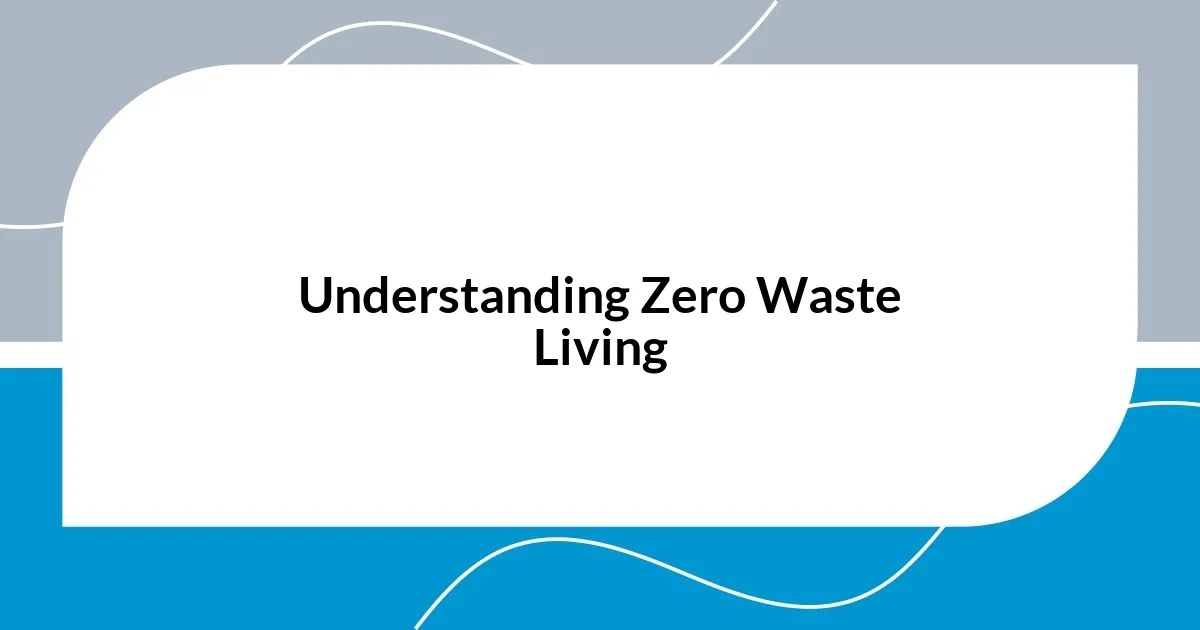
Understanding Zero Waste Living
Zero waste living is more than just a lifestyle choice; it’s a commitment to reducing the amount of waste we produce and rethinking how we consume resources. I remember the first time I walked into my kitchen after adopting zero waste principles—I felt overwhelmed by the sheer amount of packaging I’d been tossing in the trash without a second thought. Have you ever opened your pantry and realized how much single-use plastic is hiding behind those labels?
As I delved deeper into this journey, I discovered that zero waste living requires a shift in mindset. It’s not just about refusing plastic bags or carrying reusable containers; it’s about understanding the impact of our consumption and asking ourselves, “What is truly necessary?” When I started asking this question, I found myself making more intentional choices, like bringing my own jars to the farmer’s market and saying goodbye to my old habits.
This journey has taught me that zero waste living is also about community engagement and sharing resources. I often find myself swapping items with friends, from clothes to extra garden vegetables, and it’s such a rewarding experience. Isn’t it amazing how we can connect with others while simultaneously reducing waste? Each little step not only contributes to a more sustainable planet but also fosters a sense of camaraderie that makes the journey so meaningful.
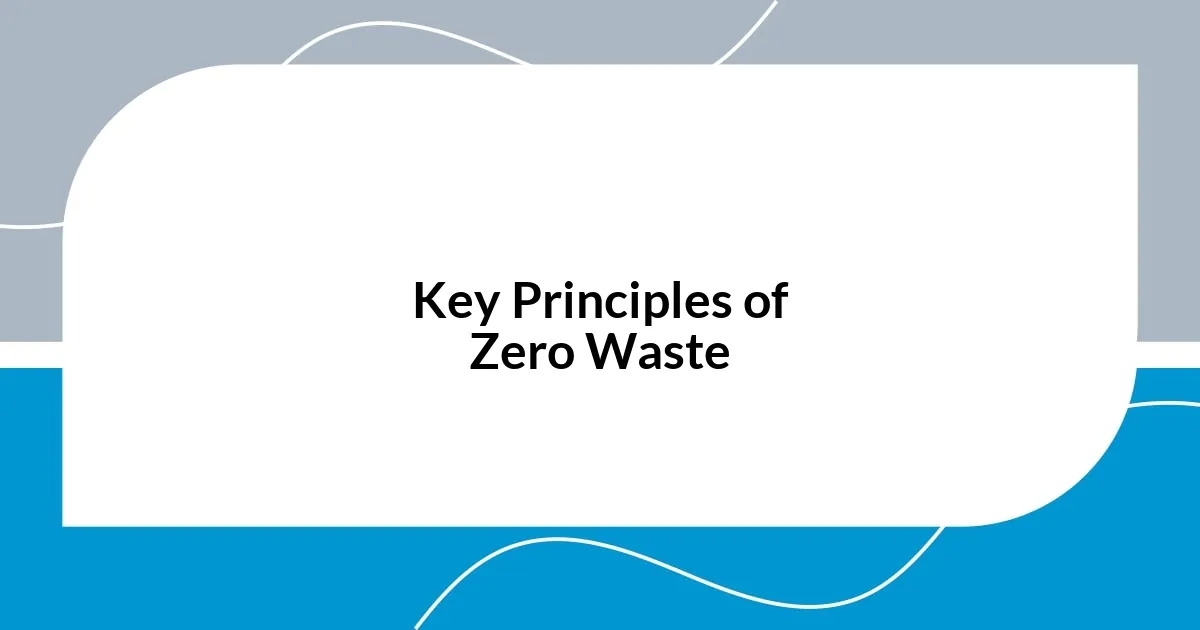
Key Principles of Zero Waste
The foundation of zero waste living rests on the 5 R’s: Refuse, Reduce, Reuse, Recycle, and Rot. These principles guide my choices and make it easier to make eco-friendly decisions daily. For instance, I remember a time when I hosted a gathering and decided to refuse all disposable dishes. Instead of plastic plates, I used my collection of mismatched china. Not only did it add a unique charm to the event, but it sparked conversations about sustainability among my guests. Isn’t it fascinating how one choice can inspire others?
Another key principle that I hold close is the idea of reducing consumption. I often assess my needs before purchasing anything new, which has led me to discover the joy of minimalism. I once had a habit of buying clothes impulsively. Now, I take a moment to consider if a piece will serve a real purpose in my wardrobe. When I do this, I not only save money but also create a space that feels lighter and more intentional. This shift has been liberating—hasn’t it made you think about how much you truly need?
Lastly, I can’t overlook the importance of composting, or “Rot,” as an essential of zero waste living. I was hesitant at first, unsure about how to start, but once I took the plunge, it transformed my kitchen waste management. Watching my scraps turn into rich compost that nourishes my plants brings me a sense of fulfillment. This principle taught me how everything is interconnected in nature. It’s a powerful reminder that even our waste can serve a purpose if we let it.
| Key Principle | Description |
|---|---|
| Refuse | Declining unnecessary items and single-use products. |
| Reduce | Minimizing the amount of waste we generate by choosing sustainable alternatives. |
| Reuse | Using items multiple times and repurposing whenever possible. |
| Recycle | Sorting and processing materials to re-enter them into the production cycle. |
| Rot | Compiling organic waste to create compost, benefiting the environment. |
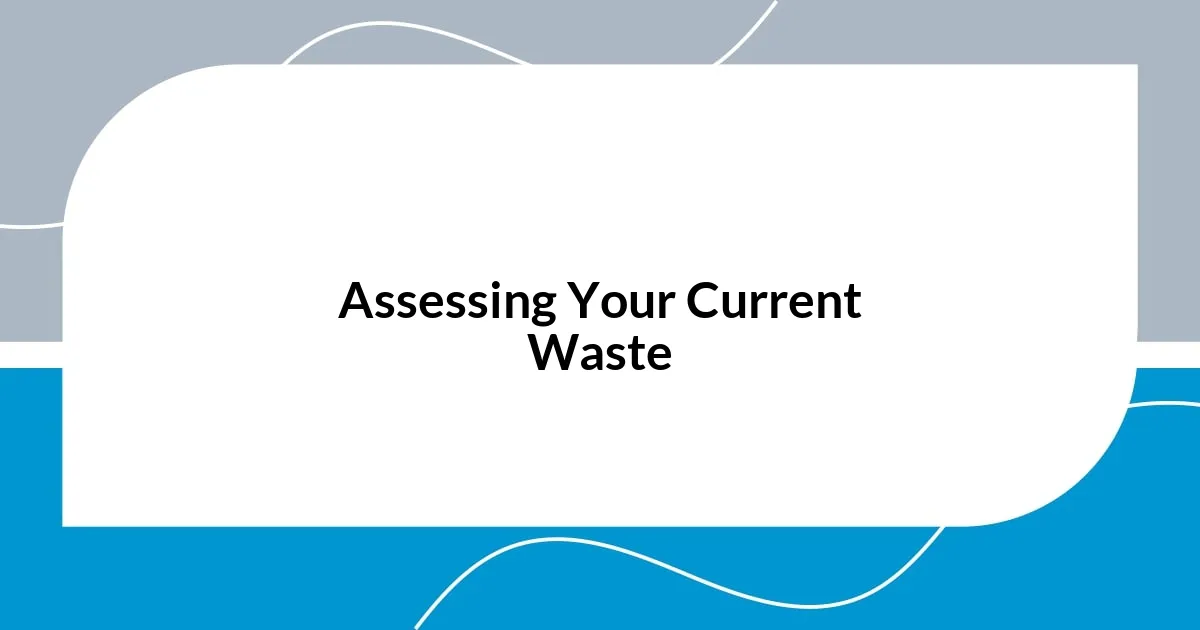
Assessing Your Current Waste
Understanding how much waste you currently produce is a crucial first step in the journey to zero waste living. When I chose to audit my waste for a week, I was surprised by the sheer volume of items that filled my trash bin. It’s a bit of an eye-opener to see the reality of what we throw away daily. I found that even seemingly small items, like food wrappers and coffee cups, added up quickly.
To get started with your own waste assessment, consider these steps:
- Keep a Waste Diary: Track what you throw away over a week. You’ll likely discover patterns and surprises.
- Categorize Your Waste: Separate items into categories like plastics, paper, food scraps, and miscellaneous. This will help you identify the major contributors to your waste.
- Reflect on the Why: Take note of the items you frequently discard and ask yourself if they can be refused, reused, or recycled. For example, could you make homemade coffee instead of relying on takeout cups, as I did?
- Visualize Your Impact: Sometimes, I look at my trash and think about how that waste affects the environment. This emotional connection can motivate changes in habits.
Through this process, I found that awareness breeds mindfulness. Each item I tossed out became a lesson that nudged me closer to sustainable choices. It’s a bit like facing a mirror and recognizing the areas that need change, which can feel daunting but ultimately empowering.
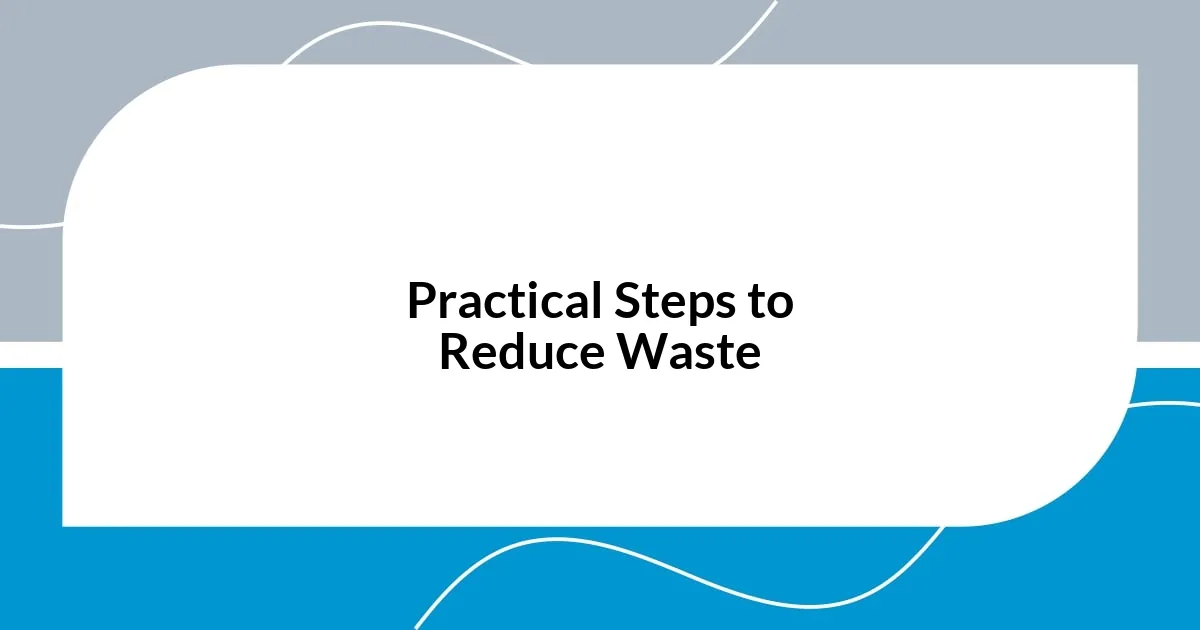
Practical Steps to Reduce Waste
When it comes to practical steps for reducing waste, I find that starting small can yield significant results. For example, I decided to carry a reusable water bottle with me everywhere. It might sound simple, but I’ve saved countless plastic bottles over time, and honestly, it feels good to take a proactive step. Have you ever thought about how many single-use bottles you could prevent from ending up in a landfill?
Switching to bulk buying has been another game-changer for me. I discovered a local grocery store that offers various products in bulk, allowing me to bring my own containers. It’s satisfying to fill a jar with pasta or nuts, and it significantly cuts down on packaging waste. Plus, the savings can be pretty impressive! Have you tried out bulk buying? It can be a fun experience, especially when exploring new ingredients.
One of my favorite practices is to repurpose glass jars. Instead of throwing them away, I use them for storage, organizing everything from spices to craft supplies. This not only reduces waste but adds a bit of charm to my home. I’ll never forget the first time I transformed an old spaghetti jar into a chic planter. It sparked a little creativity in me—who knew waste could inspire such fun projects? What are some items in your space that could be given a new life?
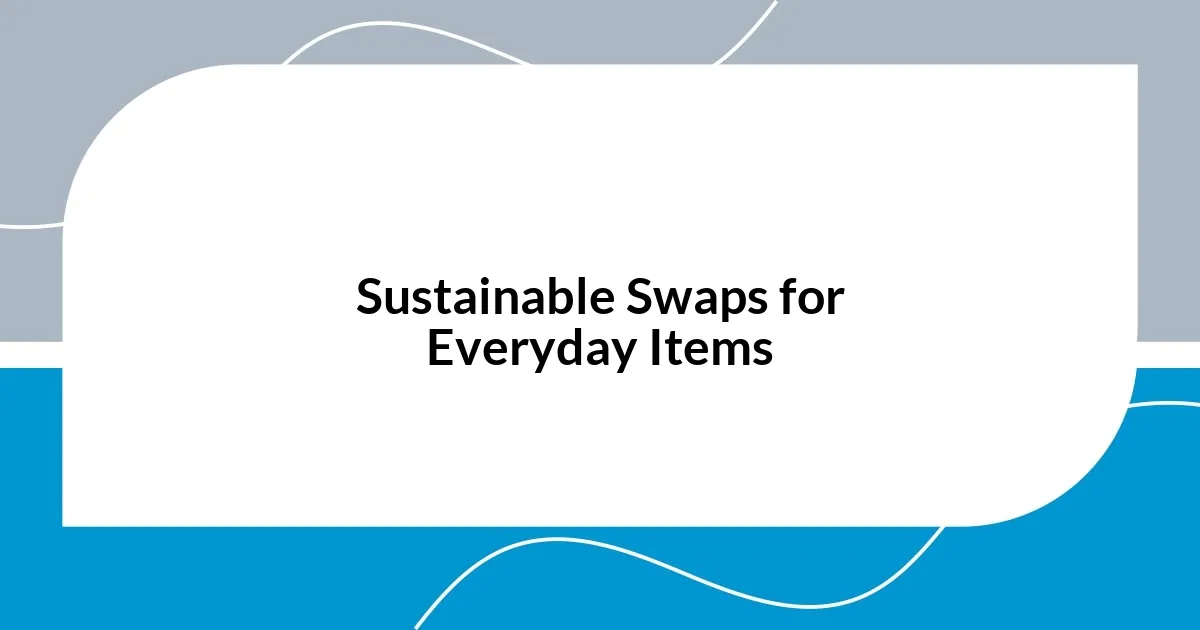
Sustainable Swaps for Everyday Items
Making sustainable swaps in our everyday lives doesn’t have to be overwhelming. I remember the first time I replaced plastic kitchen sponges with natural loofah sponges. At first, I was hesitant, but I quickly learned they not only worked just as effectively but also broke down more easily in compost. It was a small change, yet it made me feel like I was contributing to a larger solution. Have you ever considered how seemingly insignificant items like sponges can impact our planet?
Another impactful switch for me was swapping out conventional grocery bags for reusable ones. Initially, I would forget them at home, but now they’re a staple in my routine. Every time I hand over a reusable bag at the checkout, I can’t help but feel a surge of pride. These little victories remind me that we can take control and make a difference, one bag at a time. What about your shopping habits—how can you reduce waste with something as simple as a bag?
One area where I’ve found great joy in sustainable swaps is in personal care products. By choosing solid shampoo bars, I not only cut down on plastic bottles but also discovered a new routine for my hair care. The first time I lathered up with a bar, I was amazed at how luxurious it felt. It makes me think: isn’t it interesting how small changes can lead us to discover new favorites? If you consider alternatives to your daily products, what could you uncover?
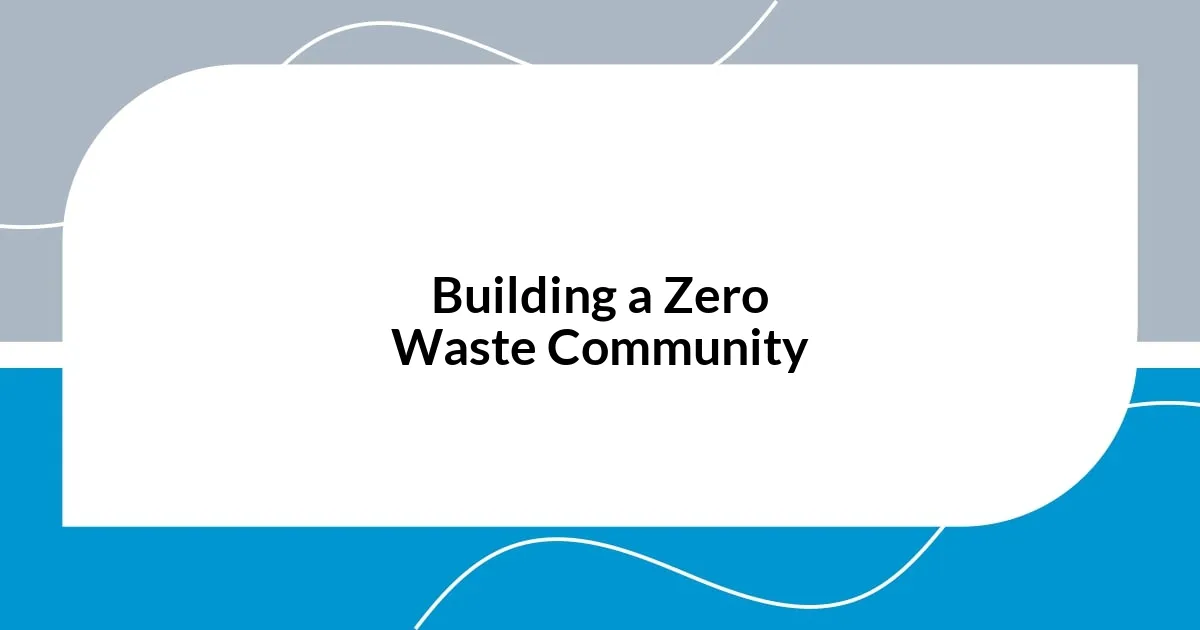
Building a Zero Waste Community
Building a zero waste community starts with connection and collaboration. I remember when I first joined a local group focused on sustainable practices. The energy in those meet-ups was contagious! We shared tips, successes, and even challenges, turning what once felt like an overwhelming journey into a fun collective effort. Have you ever experienced a sense of belonging within a group that shares your values?
Organizing community clean-up events can also foster a strong sense of purpose. I participated in one last summer, and it felt incredible to see so many people coming together for a common cause. Not only did we pick up litter, but we also educated each other about the importance of reducing waste in our neighborhoods. How gratifying is it to witness tangible change right in your backyard?
Setting up community resource exchanges is another innovative way to support zero waste living. Inspired by a local initiative, I helped coordinate a swap event where folks could trade items instead of sending them to landfills. Watching my neighbors excitedly exchange books, clothes, and household items was heartwarming. Have you thought about what you could share with your community to give a second life to items that no longer serve you?